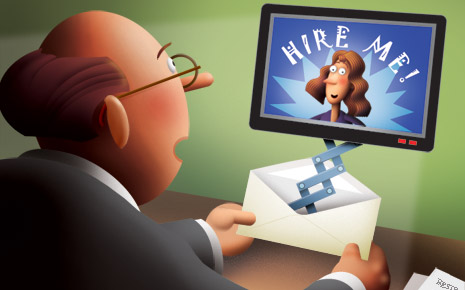Getting in the door with a multimedia resume
Some job seekers forgoing traditional resume to set themselves apart
 |
|
|
Duane Hoffmann / msnbc.com |
|
Your
Career |
|
Send us your career questions
Got questions about your career or life in the workplace? Send them to msnbc.com columnist Eve Tahmincioglu, author of 'From the Sandbox to the Corner Office.' Send e-mail to Eve | Follow Eve on Twitter |
“I had to take a different approach,” he explains, but he didn’t quite know what to do. That is, until he came across a video resume site called InterviewClips.com and thought, “What do I have to lose?”
He quickly made a video resume and decided whenever he applied for a job online that he would upload a cover letter with a link to the video instead of a standard resume.
Bingo!
Not only did employers start calling, but he ended up landing a job as budget manager and assistant to the dean of the University of San Francisco’s nursing school in March. He believes the video resume set him apart.
“Of all the 55 or so applications we received, Ryan's was the only one who had a video resume attached,” says Jossie Orense, who was an assistant to the dean at the time he applied for the job.
The video resume definitely helped get him in the door, she says. “It was our first time to ever receive a video link, we were curious about what he had to say.”
In this tough economic environment, more job seekers are looking for ways to set themselves apart, and some have decided the bedrock of the job search — the traditional formatted resume — needs to go the way of the Flintstones.
Multimedia resumes that allow you to include photographs, samples of your work, videos and even Twitter feeds are gaining favor. In addition, people in the job hunt are using their own Web sites, blogs and social networking sites such as LinkedIn, in lieu of or as a supplement to, the traditional resume.
More job applicants
going digital
While there are no hard statistics on the growing
use of such unconventional resume alternatives, hiring managers and human
resources experts across the country say they’re definitely seeing more
applicants that are going digital with their resumes.
“It’s an increasingly competitive job market and people are trying to distinguish themselves from the crowds by using different platforms and media,” says Robert Pietrykowski, assistant vice president of human resources at Cleveland State University.
Lauren Wilson, a graduate student studying human resources at Missouri State University, had been looking for a paid internship outside her state since August, but only got serious interest when she opted to create a multimedia resume.
The online resume includes her photograph, samples of her work, and a link to her LinkedIn profile; and she can now track who looks at her cyber resume.
“I wanted to show my work and my face, and express my passions,” she says.
Within a week of sending out her multimedia resume, she heard from Yahoo. She starts her internship at the search engine company next month, and is relocating to the company’s headquarters in Sunnyvale, Calif.
“I can’t say I got the job because of it, but I think it made me seem more legit. Being from southwest Missouri, maybe people didn’t take me as seriously,” she surmises. “I think having the multimedia resume made the difference.”
Sponsored links
Open an Account Online Today! $7 Trades & Powerful Trading Tools.
http://ad.doubleclick.net/clk;212400544;33779305;y?http://pixel.quantserve.com/r;a=p-d01keUhbGfE7Y;labels=_click.adserver.doubleclick,_click.publisher.MSN,_click.placement.MSNBC+Text*http://www.scottrade.com/LP/whychoose/1c.asp?id=1

Resource guide


